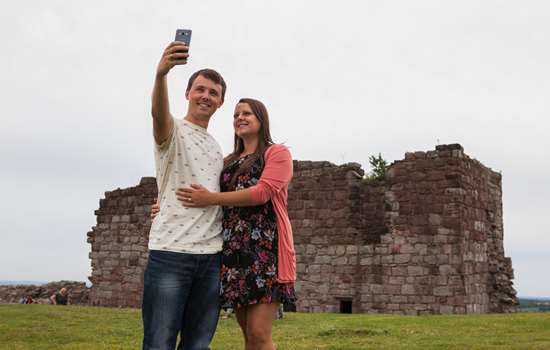1. Eltham Palace and Gardens
The Courtaulds gave their medieval palace a modern spin in the 1930s. Their gardens are no exception, and with the help of former Assistant Director of Kew Gardens, John Gilmour, they set about transforming the landscape too. Summer is the best time to enjoy this rare surviving example of a 1930s garden as it bursts into vibrant colour.
Picnic beside the Courtauld's fashionable Rock Garden or take a break in the Sunken Rose Garden. Here you can find historic varieties like Rosa 'Gruss an Aachen' and a range of hybrid musk roses such as R. 'Felicia' as well as fragrant lavender.
Wander around the bedding on the Rampart Steps where the herbaceous border flowers all summer. Catch it in full bloom from August to October.
Visit Eltham Palace2. Witley Court and Gardens
One of England's great country houses, Witley Court is fondly remembered for its extravagant Victorian garden parties. Experience its outdoor charm this summer with ornate parterre bedding featuring begonias, penstemons, Osteospermum Heliotrope, pelargoniums and yellow zinnias.
A summer visit is not complete without exploring the enchanting Victorian wilderness. Follow the winding paths and look out for climbing plants such as honeysuckles as they wrap themselves around the trees. Keep your eyes peeled for Aesculus pavia, known as the firecracker plant for its bright red flower spikes in early summer.
It will be hard to miss the grand Perseus and Andromeda fountains, which fires every day from April to the end of October. See for yourself why these elaborate fountains are compared to Rome's Trevi Fountain and those at the Palace of Versailles near Paris.
Visit Witley Court3. Osborne
Queen Victoria frequently wrote about her love of Osborne's gardens. From painting on the terrace, to helping Albert in the garden, it's little wonder she called Osborne her 'paradise'. Take a stroll around the vast seaside estate and see why she chose to spend her summers at Osborne. In the summer bedding, see rich hot colours of the flowers including Victorian favourites such as fuschias and pelargoniums contrasted with gold, silver and variegated foliage plants.
Recently, we re-opened the lower terrace after a period of conservation and repairs to the area including the fountain and shell alcove. While you're here, look out for Osborne's famous myrtle. Fans of the royal family may have seen this in Meghan Markle's bridal bouquet in her wedding to Prince Harry. Osborne's myrtle continues to grow from a sprig which was given to Victoria by Albert's grandmother in 1845. It has been used in royal wedding bouquets for generations and has been carried by brides including Victoria's daughter, also named Victoria, Queen Elizabeth II and Kate Middleton. The myrtle flowers in July and August.
Visit Osborne4. Brodsworth Hall and Gardens
Brodsworth's Victorian gardens are almost exactly as they were during the late 19th century. Discover the statue walks, fern dell grotto and exotic summer parterre to get a sense of the life of the wealthy Thellusson family, who built the home and gardens in the 1860s.
In the pleasure grounds, set in an 18th-century quarry, smell the fragrance of more than 100 rose plants. Compare this to the wild roses of the Rose Dell in the mid-summer, flowering in warm shades of pinks and reds.
While you're exploring the gardens, discover the restored privy – a Victorian loo that was hidden under a mountain of ivy for decades. The restoration features a pagoda-styled roof and strongly-scented flowers including roses and geraniums. We've also recently restored the game larder, one of few surviving examples in the country. As part of the restored garden, enjoy the serenity among strawberry trees, scots pines and Buxus sempervirens around the newly landscaped paths.
Visit Brodsworth5. Walmer Castle
Given to the Queen Mother for her 95th birthday in 1997, the Queen Mother's Garden commemorates her role as Lord Warden of the Cinque Ports. At the time she said, 'I have been given many presents before, but never a garden.' The garden was designed by celebrated landscaper Penelope Hobhouse, whose design style fitted well with the colours and styles enjoyed by the Queen Mother.
During summer, Walmer's Kitchen Garden is in full production with a spectacular offering of soft fruit, vegetables and flowers. Some produce is grown in the glasshouse, including tomatoes, peppers and aubergines. A permanent display of houseplants, cacti and succulents can also be admired here.
The double border of the Broadwalk is superb throughout the summer with drifts of plants such as bear's breeches (Acanthus spinosus), spiked blue Echinops ritro, the tall yellow Cephalaria gigantea, goldenrod, (Solidago), and dark pink Persicaria amplexicaulis, all set against the dark green of the 'cloud' yew hedge.
Don't miss the stunning Glen with its evergreen planting and wonderful ferns, plus the restored key-hole view from the top of the pleasure gardens, and the various further hidden treasures as you explore the woodland walk at Walmer.
6. BELSAY HALL, CASTLE AND GARDENS
Beautiful musk roses cast an enchanting summer spell across the gardens at Belsay in early summer. During the warmer months the Formal Terrace is a real treat. Here you can take in the views of the brightly coloured Rhododendron Garden. These hybrids were planted between 1904 and 1930 and flower in a pretty pattern of pink, mauve, red and white during June.
In the quarry garden marvel a mixture of exotic ferns like Dicksonia antarctica, and the leafy Gunnera manicata with its leaves measuring up to 6ft wide and up to 11ft long. Look out for the Davida involucrata, also known as the 'dove-tree', 'ghost tree' or 'handkerchief tree'. In late summer it produces round flower heads and when a breeze blows, the tree appears to be covered by fluttering white handkerchiefs, hence the name.
Visit belsayMore to explore
-

Things to do every day this summer
-

Things to do in England
-

Become a member
